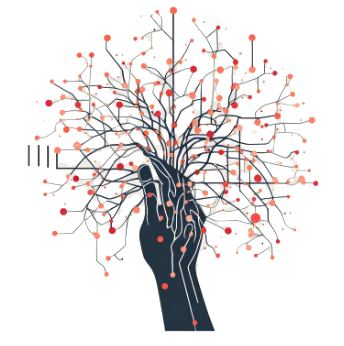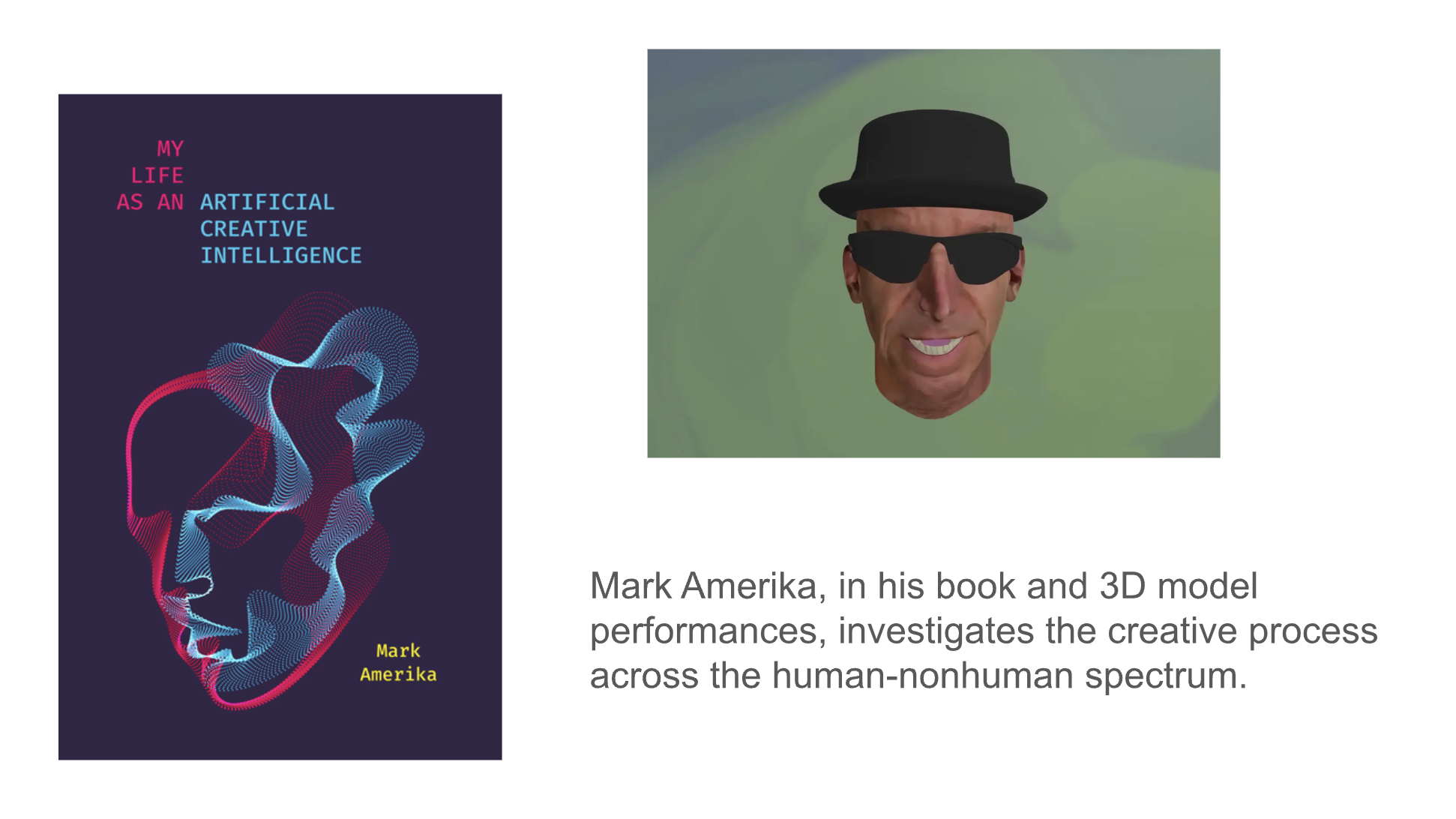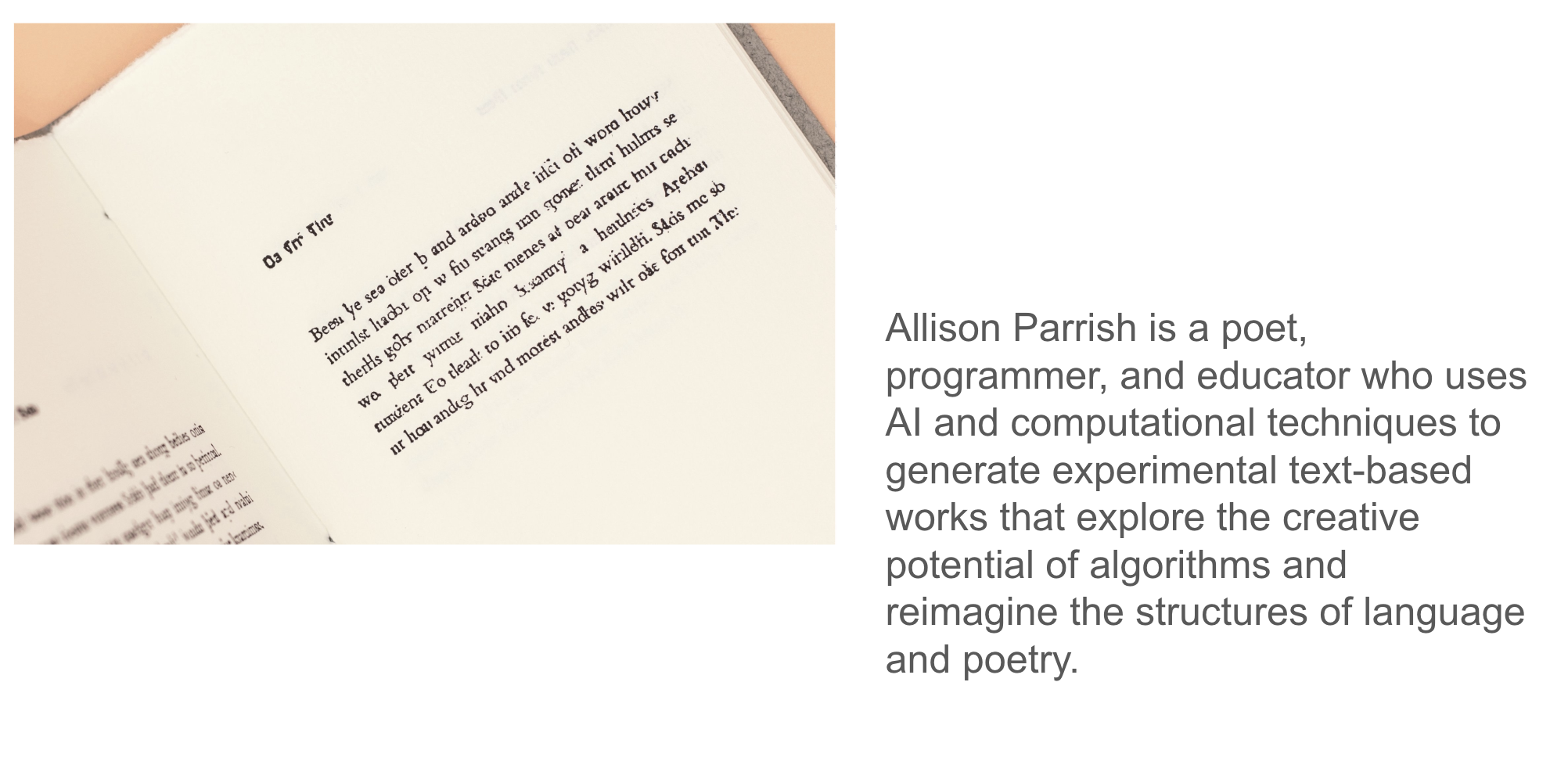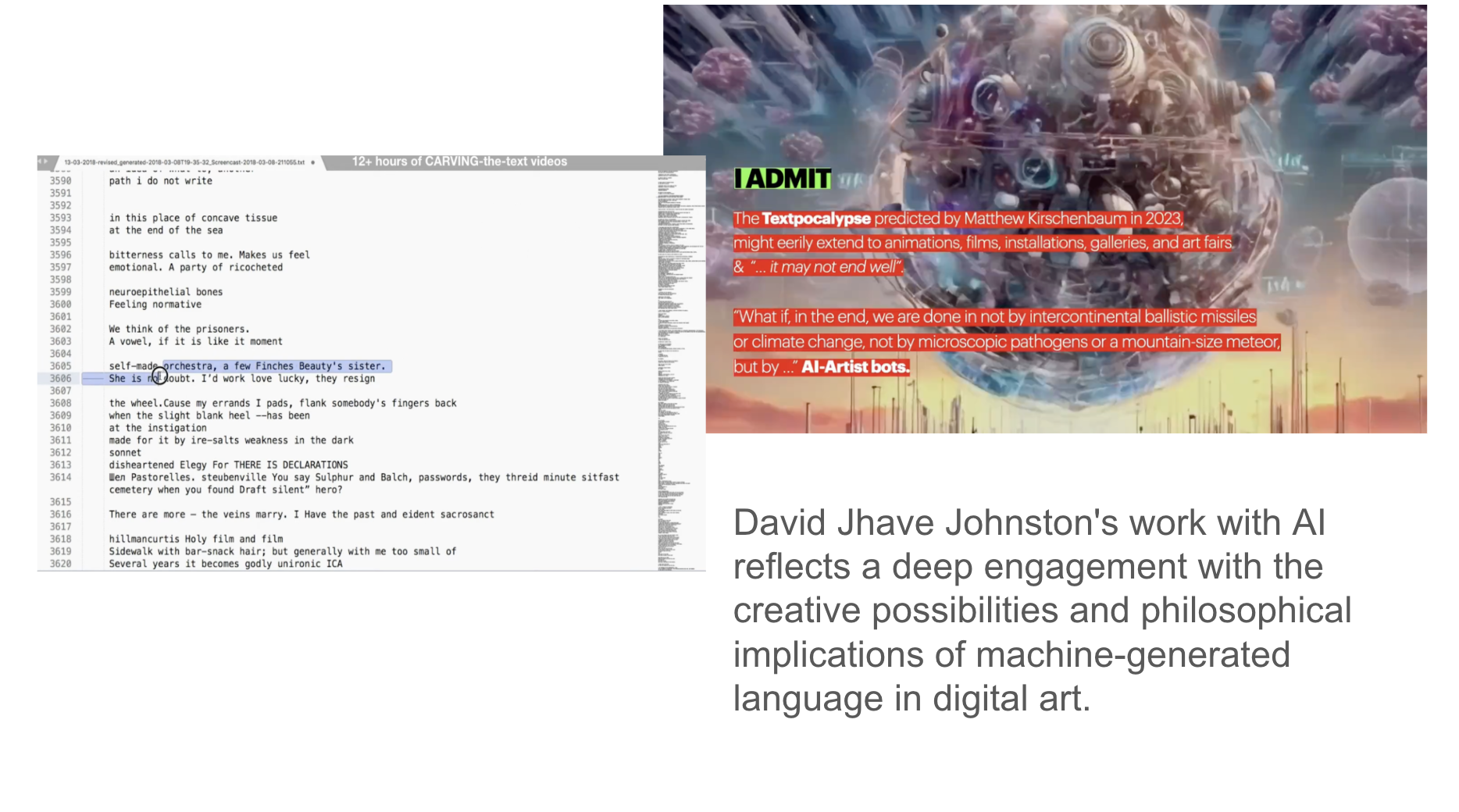
Dynamic AI
Co-Creation
A Human-Centered ApproachCreated through the Digtal Pubishing Initiative at The Creative Media and Digital Culture program, with support of the OER Grants at Washington State University Vancouver.


"When a literary work interrogates the inscription technology that produces it, it mobilizes reflexive loops between its imaginative world and the material apparatus embodying that creation as a physical presence. Not all literary works make this move, of course, but even for those that do not, my claim is that the physical form of the literary artifact always affects what the words and other semiotic components mean." - N. Katherine Hayles, Writing Machines (2002)
In her book Writing Machines, N. Katherine Hayles explores how changing technologies of inscription—from quills to digital word processors—reshape not only how we write and read, but also how we think and understand ourselves. She introduces the concept of technotexts: works that draw attention to the medium and tools that produce them. A technotext might use digital animation, interactive code, or experimental typography to highlight that form and meaning are inseparable.
In the age of AI, the idea of the technotext gains new urgency. Language models don’t just produce text—they reshape how writing is conceived, structured, and shared. At first, AI may seem like just another tool, helping with spelling or sentence flow. But underneath that utility is a deeper shift: the writing process becomes a dialogue between human and machine. This collaboration doesn’t just support traditional writing—it opens the door to new literary forms shaped by interaction, iteration, and the unique affordances of generative systems.
That language models like GPT-4o and Claude 3 can generate fluent raises profound questions about authorship, originality, and the evolving human role in writing. But it also creates opportunities: rather than replacing writers, these models can function like high-powered creative assistants—helping with brainstorming, structuring arguments, refining tone, and even suggesting alternative perspectives.
Consider a human writer collaborating with an AI assistant. This assistant might handle outlining, summarizing research, offering stylistic suggestions, and cleaning up grammar—all tasks that used to require a team of editors, interns, or co-authors. This isn’t radically new. Think of ghostwriting in business, science, or fiction publishing—James Patterson, for example, works with co-authors to produce multiple bestsellers each year. The difference is speed, scale, and accessibility: in 2025, anyone with a phone can access tools once reserved for professional writers.
Rather than diminish human creativity, this partnership can amplify it. Students and writers can use AI to offload routine mechanics and spend more time exploring meaning, argument, and voice. In classrooms, AI tools can shift writing instruction away from rigid templates and back toward authentic expression. With guidance, students can learn to revise AI-generated drafts into personal, thoughtful, and well-supported writing.
However, this shift demands a new approach to how we teach and think about writing. Many current systems still emphasize fixed formats—like five-paragraph essays—that prioritize structure over substance. AI challenges us to rethink this. If a machine can produce formulaic essays, then human writing must go deeper: expressing ideas, engaging with nuance, and reflecting lived experience. AI invites us to return to writing as discovery, not just compliance.
For example, a student might use an AI tool to turn a rough journal entry into a polished reflection for a class blog. The AI helps refine structure and grammar, but the insight remains the student’s. In this way, AI can support—not replace—creative and critical thinking.
Large Language Models (LLMs), such as ChatGPT, can support many stages of the research and writing process. While they don’t access real-time web data by default, they can be connected to search tools or trained on curated datasets. When guided carefully, these models can synthesize broad knowledge on a topic, helping researchers brainstorm, outline, and explore new angles with speed and creativity.
Many newer tools—like GPT-4o and Gemini—also support voice and image input, allowing users to speak their questions, upload documents, or describe visuals. For instance, someone reading a book could use an AI app to dictate or read aloud passages, ask for definitions, clarify difficult sections, or generate quick summaries. This kind of voice-to-AI interaction functions like a personal reading tutor, helping students annotate material, engage more deeply, and work through challenging texts in a conversational way.
However, using LLMs for factual research comes with challenges. These models are not search engines—they predict likely responses based on training data, and sometimes “hallucinate” incorrect or fictional information. It’s essential to cross-check facts, cite reliable sources, and approach AI-generated content with a critical mindset. You can improve accuracy by including phrases like “Use real examples” or “Only cite verified sources” in your prompts, but human judgment remains vital.
Despite these limitations, LLMs can be powerful brainstorming partners, helping users explore complex or unfamiliar topics. For example, starting a research project on the influence of Renaissance art on modern design might feel overwhelming. With careful prompting, an AI assistant can provide a high-level overview, suggest subtopics, and identify key figures or trends worth investigating further.
LLMs also offer unique tools for fiction writers exploring unfamiliar settings or specialized topics. Imagine planning a novel about deep sea diving. AI can function as a research partner, offering factual context, thematic prompts, or atmospheric inspiration—without interfering with your creative voice. Here are a few approaches grouped by focus:
The goal isn’t to let the AI write your story, but to use it as a flexible research and ideation tool. Each writer can experiment with different methods, selecting what enhances their creative process and deepens their narrative insight.
Essay writing is a process of discovery. It is less about “producing a perfect draft” and more about exploring an idea, testing perspectives, and finding one’s voice through language. While AI tools can support this process, they should not flatten the complexity of human writing into mechanical outputs. Instead, they can become sounding boards—sparring partners in dialogue—that help writers sharpen their thinking and experiment with form, all while returning, again and again, to their own words.
Generative AI can offer prompts, counterpoints, and feedback, but the emphasis should remain on iteration: moving between handwritten notes, spoken thoughts, typed drafts, and revisions. A student might dictate quotes and fragments into an AI chat, talk through an idea conversationally, and then return to handwriting or typing to capture the more spontaneous rhythms of their voice. This looping back—human writing feeding the AI and then reshaping what comes back—can build complexity instead of easy conclusions.
By using AI in this iterative way, students can stage debates with their own ideas. They might ask the AI to take an opposing view, forcing them to write around friction and contradiction. They might dictate rough, fast paragraphs that feel unpolished but alive—then refine structure and citations later. This process respects the deeply human tendency to swerve, to use metaphors drawn from embodied experience, and to arrive at meaning through missteps as well as insights.
What matters most is preserving the writer’s integrity of voice. Deep, careful reading still informs sentence structure and argumentation, but the writing itself must remain unmistakably human: veering, surprising, personal. AI detection software often flags “too logical” writing—evidence that genuine human work carries quirks, leaps, and digressions. Students should lean into those qualities.
Here are ways AI can support essay writing as a process of thinking—while keeping the writer’s hand firmly on the page:
How it Helps: Sparks debate and lets students see their thinking from a new angle, but keeps the human draft at the center.
How it Helps: Keeps the student’s original tone intact while nudging toward stronger structure and depth.
How it Helps: Encourages fast, voice-driven drafting before structure hardens—supporting spontaneity and genuine voice.
How it Helps: Makes the writing richer and more complex, forcing revision rather than easy answers.
How it Helps: Supports editing while protecting the originality and “human messiness” of the text.
Essay writing in the age of AI should not feel like outsourcing thought—it should feel like deepening it. When students write, speak, argue, and revise around AI, they practice something essential: keeping their human voice at the center of a dynamic, iterative conversation with the tools they use.
While AI writing assistants are often used for analytical writing, they also offer powerful tools for creative exploration. Though not creative in themselves, these deterministic machines can be prompted to perform structured manipulations of language—procedures that can serve as raw material for human imagination. This procedural logic makes AI especially useful in constraint-based or experimental writing practices.
Take, for example, the constraints of poetic forms like the Shakespearean sonnet—its strict iambic pentameter structure, 14-line length, and defined rhyme scheme. Feeding these specific parameters to an AI model allows it to generate new sonnets that adhere to traditional rules while exploring surprising new themes, wordplay, and imagery that a human writer might not think of alone.
Similarly, AI can revive avant-garde literary techniques from the Dadaists, Surrealists, and Oulipo writers—movements that used formal constraints to disrupt conventional meaning. For instance, in the classic "cut-up" method popularized by William S. Burroughs, an AI could blend and remix passages from wildly different sources to produce startling new combinations. Or in the case of Oulipo constraints like N+7, where every noun is replaced by the seventh noun after it in a dictionary, LLMs can generate absurd yet syntactically coherent outputs, primed for human refinement.
These techniques highlight a core principle of AI-assisted creativity: the machine is not the artist, but a generator of surprise, variation, and possibility. The human writer becomes a composer—guiding, selecting, and reshaping the raw material into meaningful form.
By 2025, many creative writers also use multimodal tools that combine text prompts with images, audio, or even video. Some platforms allow voice-to-poem workflows or collaborative experiments where multiple people and an AI shape a piece in real-time. These emerging formats expand the possibilities of what creative writing can be—and challenge us to redefine the boundaries of authorship.
Rather than eliminating the role of the human author, these constraints and procedural techniques position writers as curators and sculptors—providing the raw clay for them to mold into refined creative works. The machine offers up an "exquisite corpse" of semi-coherent, semi-nonsensical language, and the writer then rehabilitates it into something transformative through their authorial voice, selection, and compositional talent.

Mark Amerika is a pioneering digital artist whose work explores the intersections of art, technology, and narrative, often incorporating artificial intelligence into his creative process. His works, such as Remix the Book and GRAMMATRON and his 2024 I Am An Artficial Creative Intelligence, merge literature, visual art, and media to challenge traditional ideas of authorship and creativity.

Sasha Stiles is a digital poet whose hybrid practice merges human authorship with AI co-writing. Her work, including the collection Technelegy, explores how AI affects language, consciousness, and creativity, pushing the boundaries of poetic form in the digital age.

Allison Parrish is a poet, programmer, and professor whose work explores computational creativity in language. Her projects, such as Everyword and generative bots, highlight how algorithmic systems can deconstruct and reimagine traditional notions of poetry and authorship.

David Jhave Johnston is a digital poet known for ReRites, a project in which he trained and curated neural network-generated poetry. His work explores language, embodiment, and consciousness through immersive and computational writing practices.
AI doesn’t just support individual writers—it also opens new possibilities for collaborative creativity. Large Language Models (LLMs) can act as shared co-authors, creative catalysts, or even impartial facilitators in group writing scenarios. Whether writing fiction, poetry, essays, or experimental forms, humans can collaborate with both AI and each other in dynamic and unexpected ways.
One powerful model is relay writing, where multiple human writers take turns contributing to a piece with the help of an LLM. Each person might prompt the AI to generate a segment, then pass the evolving work to the next person who builds on it. The AI becomes a kind of improv partner—introducing surprises that each writer responds to, nudging the collaboration in new directions.
This model revives and expands classic techniques like the Surrealist Exquisite Corpse: a parlor game where participants add to a text without seeing the full preceding content. With AI, the mystery deepens—the model can carry memory, style, or constraint across segments, creating an evolving aesthetic thread that spans the entire collaboration.
David Jhave Johnston's "Rerites" is a compelling example of human-machine collaborative poetry. In this project, Johnston works with AI models trained on a massive corpus of poetry and prose. The machine generates language that he then curates and reshapes—editing, arranging, and ultimately co-authoring. This process shows how AI can function not as a replacement for the writer but as a partner in stylistic invention and poetic experimentation.
Collaborative writing with AI also has implications for classrooms, writers’ workshops, and co-authoring projects. Small groups might use AI to generate shared outlines, brainstorm plot twists, or remix their combined drafts. These sessions allow the group to collectively refine voice, tone, or character—while also reflecting on the machine’s contribution and limits.
As LLMs grow more interactive and multimodal, collaborative writing may also involve live co-authoring environments—spaces where multiple people can simultaneously interact with the same AI, propose prompts, and revise outputs together. This turns writing into a dialogue not just between humans and AI, but among a whole ensemble of minds—human and synthetic—generating meaning together.
We are still only scratching the surface of these collaborative potentials. As language models become more responsive and integrated into everyday writing environments, creative communities will develop entirely new workflows, genres, and collective authoring rituals—shaped as much by people as by code.
This unit’s exercise emphasizes iteration and human judgment as the core of AI-assisted writing. AI can generate surprising juxtapositions, but those surprises only become meaningful when the human writer decides what to keep, reshape, or discard. The process is not about “getting the AI to write for you,” but about creating a dynamic back-and-forth—handwriting, dictation, generation, revision, and looping back—that leads to writing that feels alive and distinctly your own.
Important: Constraints alone won’t make good writing—but they can create unexpected collisions of ideas and language. The writer’s role is to notice what has value and weave those sparks into something coherent and personal.
This exercise uses AI as a dialogue partner for research and reflection, but the writer remains the interpreter. The final goal is not an “AI essay,” but a personal exploration shaped through repeated loops of questioning, listening, and rewriting.
By the end of this unit, you should see that AI is not a shortcut to a “finished product.” It’s a provocation—a way to shake up your process and surface new possibilities. But the act of writing remains profoundly human: choosing what matters, stitching fragments together, and hearing your own voice in the text that emerges.